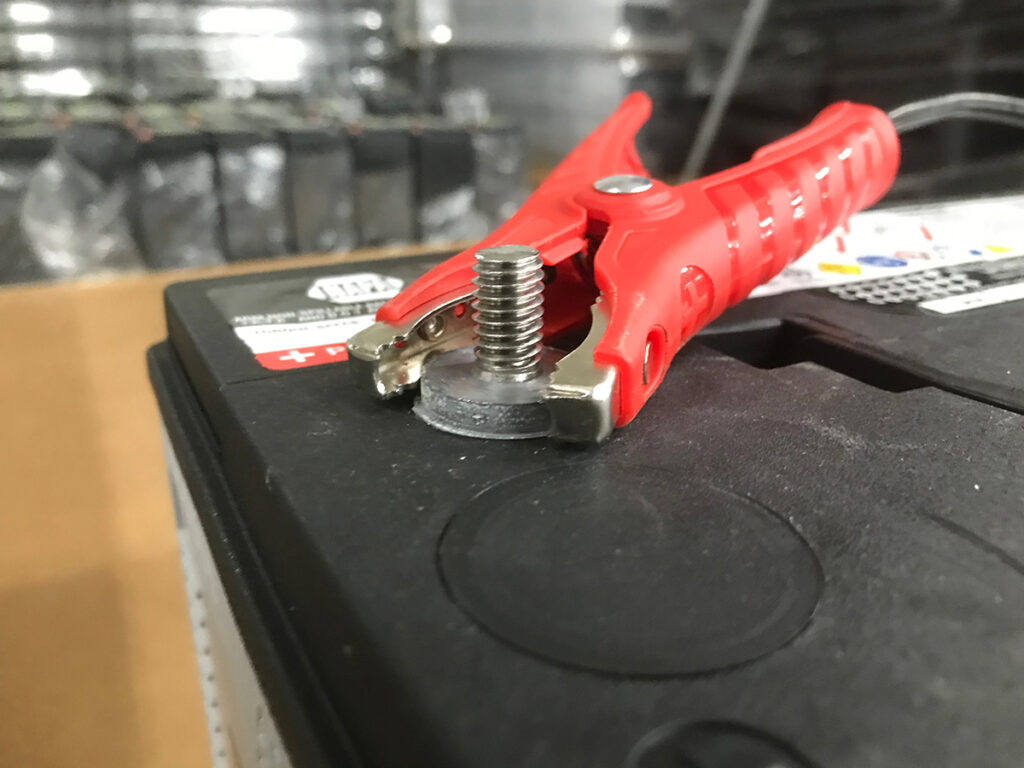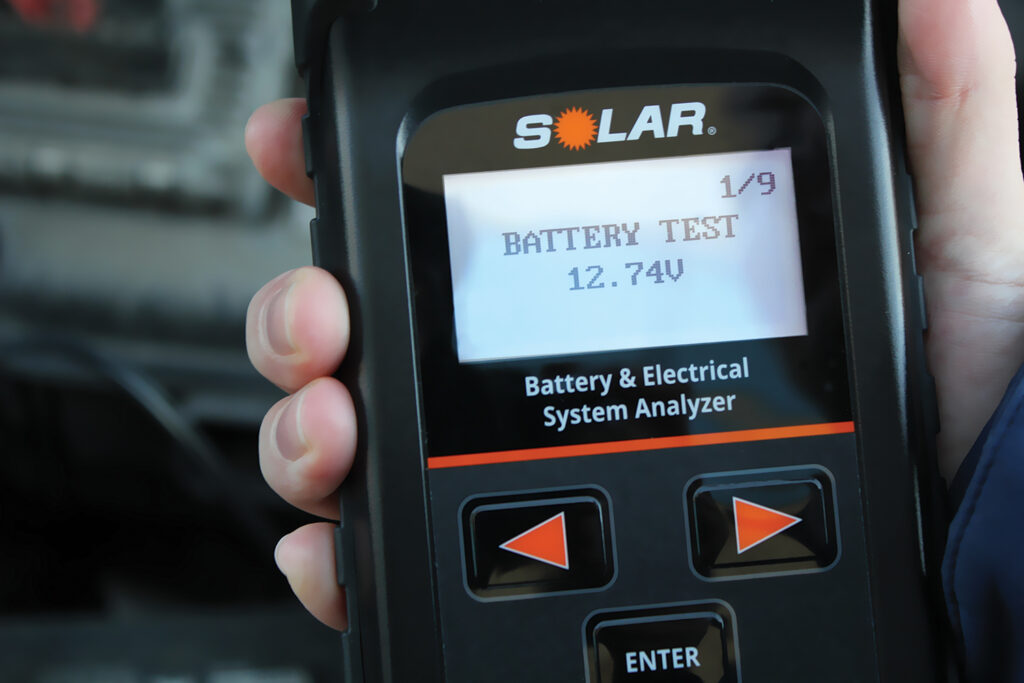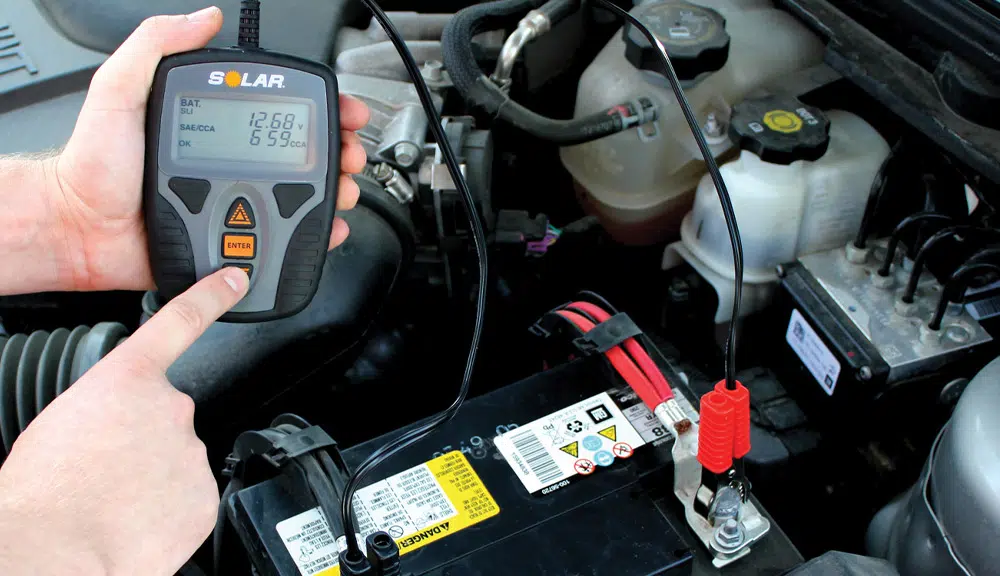Batteries are a wear item. That’s a fact. Whether you purchase a budget battery or the most advanced AGM battery, at some point it will fail. Whether you live in Phoenix and experience extreme heat much of the year, Grand Forks, SD and experience extreme cold, or in San Diego and have weather most of us would trade for in a minute, your battery is going to die (hint: it will last longer, all things being equal, in San Diego). This makes battery testing critical for vehicular happiness, whether you are a vehicle owner hoping to avoid a future No Start situation or a shop trying to provide the best possible service to your customers.
Battery testing doesn’t have to be overly complicated or difficult, especially if you keep in mind a handful of guiding principles that will allow you to get the most accurate and predictive result. Batteries are relatively predictable and (usually) behave according to a pattern tied to their lifecycle. That said, there are always twists and turns if you test enough batteries in enough vehicles. So, as is true for almost any aspect of vehicle repair and maintenance, deploying a repeatable, logical diagnostic strategy is critical. Below, we’ll suggest a few components of such a strategy.
The Connection is Critical

A theme you will hear expressed a lot in this article is that accuracy comes from making good decisions and putting in the effort, and nowhere is that more true than when it comes to making a good connection. This has many implications, but is most obvious when testing a battery installed in a vehicle. Sometimes, the battery posts are easily accessible despite the vehicle connections, but often they are not. If the battery’s terminals are obstructed by harnesses and other connectors, it is worth the effort (and hassle) to remove those connections to provide proper access to the battery terminals. This can make a huge difference in the results you receive, since those harnesses can (and often do) add resistance, which your tester sees as inside the battery. If you must test through the harness or other hardware, make sure it is tightened properly on the battery posts and that there are no signs of battery corrosion or rust in the connection – this is not ideal, but much better than testing through loose or corroded connections.
In addition, it is important to review the battery design and factor for that specific design when planning your testing regimen. A great example is a battery designed with a terminal composed of a lead base with a steel threaded stud protruding above (see photo). This one can be tricky. You’d think, connect to that threaded stud and you’re good to go. Not so fast. Connecting to the lead base (which isn’t always easy) yields a much more accurate read on the battery’s condition. This sort of makes sense – harnesses and other connectors are typically flat and secured/smashed against that lead base, so the connection isn’t really with the stud but with the base.
State of Charge Matters

But, surface charge can cause issues in the testing process, depending on the testing method used. If using an invasive load tester, surface charge is not a big concern, because the testing process will pull down that surface charge almost immediately. If using an electronic tester, it is best to relieve the battery’s surface charge by adding a load to the battery, such as turning on the high beams for 15 seconds. This will stabilize the battery, allowing you to get a more accurate assessment of battery health and reduce the likelihood of a “charge and retest” result.
What about low SoC batteries, do they also need special handling? Again, it’s a yes and no, but this time in the opposite direction. For invasive load testing to be accurate, the tested battery needs to be at or above 85% SoC when tested. If it is below this level, which is likely, considering that problem batteries are what get tested the most, it must be charged prior to testing. This takes time, potentially slowing down the diagnosis and eventual repair, but it is absolutely necessary to achieve an accurate result. One of the great benefits of digital testing is that you can accurately test a discharged battery. Of course, there are limits to this. For instance, even though our BA327 can read batteries down to 1.5V, we’d suggest charging a 12V battery prior to testing if it is below 7-8V.
Testing Batteries Over Time
In a recent Product Spotlight, we focused on the value of battery testing when it comes to predictive maintenance. As we noted, all batteries have a certain level of internal resistance, since their internal components are not perfect conductors of electricity. For instance, a battery’s electrodes and electrolyte are not 100% conductive. So, each new battery starts out with a natural level of internal resistance. This resistance will increase as a battery ages, due to the natural chemical process that takes place within all lead acid batteries.
Monitoring and tracking the internal resistance of a battery can be very useful in assessing where that battery is in its lifecycle. Granted, this usefulness only applies to vehicles and batteries that you will see repeatedly over time. So, for service operations that might see a vehicle for service one time or only sporadically, this aspect of battery assessment is not helpful. But, for captive fleets and other service operations, as well as vehicle owners, using battery internal resistance as a predictive tool can be very beneficial. It can essentially eliminate equipment downtime before it strikes, which has tremendous value for fleets and other captive service environments.
Testing Every Vehicle Boosts Revenues

What Testing Method is Most Effective?
This is really a trick question, since there is no “best” testing method. Ultimately, the best testing method is the one that a.) you are most comfortable with, b.) best meets your workflow and c.) you are going to use. There are essentially two approaches, without getting into more complex methods, such as using a scope, etc. The two main camps are digital testing and invasive load testing. There are pros and cons to both methods, which are worth exploring as you develop your testing regimen.
Electronic/digital testing usually involves a variant of passing a signal through the tested battery and reading the response of that signal (more on our approach below). This method has many benefits, one of the most significant of which is that you can use this method to accurately test a discharged battery. Another benefit is that it has the ability to dial its testing process in to match the battery type being tested, assuming that you are using a quality testing solution. This means that an AGM flat plate (traditionally shaped) battery can be tested/judged differently than an AGM Spiral Wound battery – side note: when going the digital route, it should be, and if your digital tester doesn’t distinguish between these battery types, you should be concerned. Another benefit is that digital testing opens the door to a much more detailed analysis of system performance than can be achieved by an invasive tester. When performing a starting system test, for example, you get a specific level that the system voltage dropped to versus watching a needle deflection in the blink of an eye. So, you get 10.2V rather than seeing the needle dip to about 10V. Often, that level of detail is important and useful. Of course, you can get that with your DIMM, but now, you’re grabbing two tools.
Invasive testing involves placing a fixed or variable load on the battery for a specific period of time and monitoring the battery’s reaction to that load, as in, “Can it hold the load or not?” Although this is a more simplistic approach, it is also fundamentally reliable. Proponents of this approach will say that’s all that matters – either the battery holds the load or it doesn’t. For most professional applications, a carbon pile (variable load) tester is the most appropriate choice since it allows the operator to dial the load in accordingly to the battery’s rating. The Battery Council International Standard is 50% of the battery’s rated CCA, so for a 600 CCA rated battery, you would load it to 300A for 15 seconds and follow the assessment provided by the tester. Is the needle holding steady in the green? Battery is good. Is the needle dropping or steady in the red? Battery is bad. Simple and straightforward.
So, where does this leave us? Well, if you’re a vehicle owner with a variety of vehicles and other toys in your stable, we’d recommend a small, quality digital tester, such as our SOLAR BA9. It is quick, accurate, easy to use and versatile. If you’re a pro… well, there are many options, but most advanced diagnostic technicians and leading shops would suggest using both methods. The reality is that there’s always that one weird battery that can fool either method. There’s also the fact that newer battery types, such as AGM and Spiral Wound batteries, don’t die on a straight line, like traditional flooded batteries do. If you’ve had a driver’s license for decades, when you learned to drive, you learned to recognize the sound of a battery reaching end of life. The starting event got dragged out and sounded awful and you knew it was time to head to Sears or your local repair shop to address your obviously weak battery. That’s not how it typically works with AGM, Spiral Wound and other newer battery types. Now, a typical customer complaint is, “On Tuesday, it was cold and the car started right up, but on Thursday, the car won’t start at all.” So, many technicians suggest testing using both methods if there’s any reason to suspect the battery is a problem, using both a digital option and a carbon pile tester.
A Complete Solution for Battery Analysis
The great news for technicians and home wrenchers is that the battery analysis offering from SOLAR provides great options for both testing methodologies. All items are designed for everyday continuous professional use and are built to our exacting standards.
Our BA Series line of Digital Battery and System Testers provides accurate battery analysis in easy-to-use packages with convenient features for efficient and hassle-free use. Our top selling professional testing tool is our BA327 Digital Battery and System Tester with Integrated Printer. It offers comprehensive testing of 6 and 12 Volt batteries and 12 and 24 Volt systems. It has an operating range from 1.5-30V and testing capacity from 40-2000 CCA. It can test many different lead acid battery types, including Flooded, AGM, Spiral Wound, Gel Cell, Start-Stop AGM and Enhanced Flooded batteries. It walks the operator through the testing process, enabling anyone in the shop to achieve an accurate, reliable battery and system assessment. It features 10’ cable reach, multilingual operation, the ability to test against numerous battery rating systems and a counter that enables shops to track the number of tests performed in any given time period.
Our SOLAR invasive tester offering also provides reliable and lasting performance for busy shops, fleets and dealerships. Our 1876 1000A Carbon Pile Tester provides variable load testing and can test batteries to 2000 CCA. It features an adjustable scale for 6/12/24V assessment, 54” cable leads to allow easy connections, and heavy-gauge clamps for efficient transfer of the load to the tested battery. It’s a beast and much loved by customers.
We hope this review of battery testing best practices proves helpful to you. For many, it is just a question of familiarity. The more you use your testing tools, the more comfortable you’ll become with them. If you are an enthusiast, your battery tester can really make your life easier. We all have more and more batteries in our life. A quality tester can help you get your arms around your battery investment. If you’re a professional, the tester can really become one of your most valued tools. It can be used to drive customer satisfaction while at the same time growing revenue. That’s an unbeatable combination.
What is your approach to battery and system testing? Are you committed to one methodology or do you deploy both methods? Have you ever had a battery-related diagnostic nightmare? We’d love to hear about it in the comments below.










8 Responses
How do either of the testing methodoligies work on the AGM batrery when there seems to be no sign of degrading untill it’s too late
The 2 methods are very basic and each has an advantage and or disadvantage. The 2 methods are digital/conductance, and Load testing.
Conductance testing was designed to allow testing of cell degradation by passing a signal into 1 post and recording its travel through the battery and back out the other post. Knowing the degradation characteristics of the materials, this is actually a very accurate way to measure the aging and decline of the cell health of a battery. It works! (It was designed to test remote mounted batteries in inclement temperatures where techs would be at risk if they had to charge and discharge and load test for minutes or hours). Since you are passing a signal through the cells, and you are measuring the degradation of that signal (using an algorithm that adjusts for temperature, voltage level, stated capacity, materials etc) the testing can compensate and still be very useful down too extremely low voltages. This can save time! (Which is the main reason it was developed). Especially on an AGM or GEL battery where the charging could take hours before you could run a load test only to find out the battery is junk anyway. A conductance tester can tell you SHORTED CELL or LOW CAPACITY even on a mostly discharged battery and you can then not waste the time to charge it and replace it immediately!
Sounds awesome right?!?
However, cell integrity is not the only thing that makes a battery good, and definitely not the only thing that makes a battery fail. imagine a chain on a bicycle. It spins the wheels when pedaled and makes the force of pedal press apply rotation and you have a tool measuring wheel speed to tell you the chain did its job. Now take a hacksaw and saw through 1 of the links 90%. If that bike is upside down on a worktable, there is no weight or pressure of resistance on the wheels which arent in contact with the ground. That 90% damaged chain will pass the RPM test forever because there is no LOAD so the chain will not break that last 10%. Every time you check the RPM sensor, it says the rear wheel is spinning when you turn the pedals, so the chain did its job and is therefore GOOD.
Flip that bike over and place a 150-lb rider on the seat and the chain will snap as son as he tries to pedal. The RPM test could not measure that, see it coming, or warn you. Its the wrong test for that type of failure.
Load testing solves that issue. In battery testing, load testing is demanding electrical current from the battery cells, either using load devices in the connected circuits (Headlight high beams and blower fans) or applying an external load (Carbon pile testing). Now you arent measuring electronic signal integrity passing through the cells. You are real-world testing the battery the way it will be used! Power was put in by charging the battery, so how stable does it deliver that power and how stable does its charge rate remain after a fixed amount of delivery?
Lets get it out of the way and say it once and for all: LOAD TESTING IS A SUPERIOR TEST IN EVERY WAY BUT CONVENIENCE. It measures the battery in ways conductance cannot. You could have a battery that has good cells and they are all fully charged and the conductance tester will accurately say “800CCA available, Charge rate 100%, GOOD BATTERY”. Then install it and for a moment its all good, then you go to crank it and there is a CLICK and the power drops from 12v down to say 5v or 3v, battery goes from full charge to suddenly seeming DEAD?!? Huh? But my Hi tech digital tester just measured it at 12.6v and 800cca?!?!
The tester probably isnt wrong. The CELLS have that voltage and potential in them. But conductance is simply a voltage level check and a signal degradation measurement. Now we are back to the bicycle chain analogy. If the internal connection of those fully charged perfect condition cells is resisted then what good are they? They have 12v and 800cca in them but you cant get to it and use it! Say the car had loose battery cables. This causes high resistance in the current flow and resistance in electricity equals HEAT! The battery post temperatures rose every time the vehicle was driven to very warm or hot levels far above normal. the connection of the battery posts to the cells inside the battery gets very hot and degrades or even breaks entirely. So now you have 12.6v and 800ccs in those tested cells, with 2 battery posts that are not able to pass the current of 200amp that the starter will draw. You Conductance test told the truth, but it had no way to see that the battery post connection was 80% severed because the signal it sends is unloaded. Its merely passed through to see how it changes in the cells, and then was easily able to pass the bad connection because there is no resistance if there is no demand.
So why test with Conductance at all? I just showed that you cant trust it???!!!
That isnt entirely true. When a conductance tester tells you it sees a shorted cell, it has identified a flaw in 10 seconds that may take 3 or 4 hours with a load tester on a discharged AGM or GEL. It saves time and flags broken and bad batteries quickly and easily usually without any recharge before testing. Its not perfect. The lower the charge in the battery the higher the chance of a conductance test saying FAIL even on a battery that may be good after charging, or giving a CHARGE AND RETEST message that will ultimately fail after charging (a battery rated at 800cca tested at 8v says charge and retest, you charge it to 12.5v and then it shows max capacity of 450cca, so it was bad already why did it ask for a charge and waste 4 hours?!?!)
Conductance testing can quickly and easily identify Internal Shorts, Bad battery cells and LOW CAPACITY of cells. Any of these problems means replace that battery and waste no further time on it! But it cannot identify resistance issues, temperature variation issues, post connectivity issues, or the load and recovery rate of the battery. All that is done using a fully charged load test. Which will also tell you in a roundabout way if you have any shorted or low capacity cells. The battery must be fully charged to run the test accurately, and if any cells are weak or shorted, or the posts have bad connectivity internally, the battery will fail the load test. (Usually 50% of rating applied for 10 seconds). It cant fake it or lie, there are no algorithms computed against theoretical values and measuring how many 200lb bench presses an athlete can do to determine if he will be a good defensive end and lead his team to a superbowl. Did the battery stay above 10v while the load was applied, and did it recover back to near full voltage after? Cut and dried. If it can do that on a load test, it will start your car!
Drawbacks of course. Load testers get HOT so they do fail and have to be repaired/replaced. Also load testing a battery is abusive and can damage it if done too long or too often. And of course the biggest reason conductance has been so popular the past 20 years: convenience. A load test requires a carbon pile, and that the battery be 90% charged or more. a conductance test you can just walk up, run it and give an answer in 60 seconds! The screens prompt you with instructions, and then make printouts for you! Conductance is fast, easy, and finds enough of the problems that many techs use it because of the time savings. The testers are small, easily mobile, and the printouts are impressive to customers.
If you want to find some problems and are OK with occasionally missing a few, . but being finished quickly on every car, conductance is a good choice. It works enough of the time that you usually stay ahead of the curve.
But if you want accuracy, if you wanna be right, the load test is the superior choice in every other way that matters.
And before you ask, there have been only a few testers that combined the 2 (Whats the point? if you are gonna do load then you dont gain much from conductance except perhaps capacity measurement and fail predictability based on degradation algorithms?). The problem with those testers is and has been the load testers break with repeat use. Its what they do. And when that happens, the other half, becomes useless as well as the algorithms are adjusted to factor in load and it wont measure accurately without it. The units broke much much more often than conductance only units and were usually expensive. So buy 1 of each if you want both styles of test.
Kelly – Thanks for your very thorough reply to Robert. The only clarifying detail we would add is that our BA Series Digital Battery and System Tester offering adds microload technology to our signal sending process. While only a fraction of the load created by a carbon pile tester, it does provide many benefits in the testing process. It reduces surface charge on a recently charged battery, it stabilizes the battery’s state of charge, it does provide enough load to sense some problems noted by Kelly and it reduces the number of “Charge and Retest” results. All of these are good things and result in a more successful and predictive (accurate) assessment of battery health. Thanks, Jim from Clore Automotive
Thank you for your detailed explanation on testing batteries. I found this article very helpful to me, an Automotive Tech for 49 years now and still at it. We as techs get very used to working day to day on common issues like you have just explained, that we take things for granted. When we read articles like the above you have just explained, it does one very important thing. It reinforces our practices to just remind ourselves how to conduct our repairs in the appropriate manner and feed guidance and knowledge helping us improve our services. Tell me and i will forget, show me and I will remember.
Cheers
Oliver M
My car is at the dealer now because of no start issue. Dealer said my battery failed all the tests and was replaced with a new battery. The car still won’t start. 2019 GNC Terrain SLT. I’m thinking they are just throwing parts at it and creating a large bill $$ for me.
The towing company tested the battery at 11.5v
Tom – Thanks for adding to the discussion. It sure can be frustrating when the electrical system starts going sideways. Keep pushing for them to get to the root cause. 11.5V is low and there could be many causes for that. We wish you all the best. Thanks again, Jim from Clore Automotive
Thanks for the informative article on battery testing. When I was much younger, I recall testing flooded cell lead-acid batteries using a hydrometer, which looked like a turkey baster with a floating weighted gauge inside. You needed access to the electrolyte, usually available with caps on the tops of most batteries in those days. A reading of the temperature-corrected specific gravity of the electrolyte would correspond to the degree of charge. Just curious if this is ever used today. Of course, it only works if there is access to the electrolyte.
William – Thanks for adding to the discussion. Yes, hydrometer testing is still used and, honestly, is a very accurate and reliable way to assess a given battery’s State of health (SoH). But, as you point out, it requires access to the battery’s electrolyte, which is impossible with today’s AGM and maintenance free lead acid batteries. As such, it is limited in application. Thanks, Jim from Clore Automotive